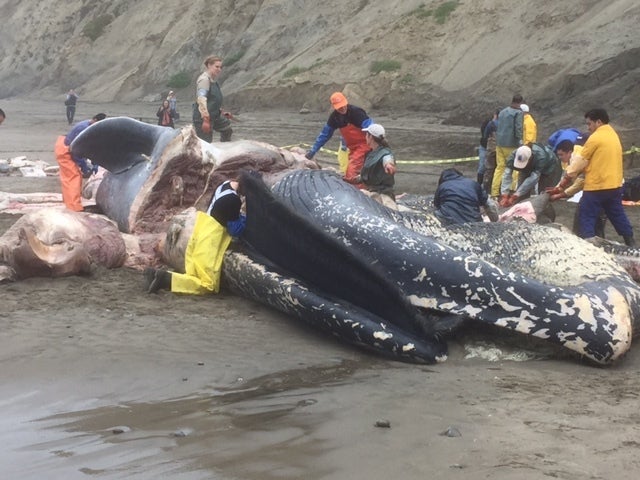
Scientists working on stranded juvenile blue whale on the Northern California coast.
Seeing the largest creature on the planet up close is a rare opportunity. That’s why when some of us in the Oakland office of the Center for Biological Diversity heard about the dead blue whale that washed up on a nearby beach in Daly City, we raced out to see it. It was a striking experience on many levels.
As we approached on the beach, we were awe-struck by the size of this magnificent creature, now drained of life and lying on its back in the sand. Then we were hit by the smell, an overwhelming, stomach-turning stench that would only get worse as it decays further. And yet a team of scientists were right in the middle of it, sometimes waist deep in blubber and organs, cutting away at the whale with long, sharp knives trying to determine how it died.
They found that this mighty blue whale had multiple skull fractures, indicating that it may be the latest victim of being struck by a speeding ship. It could take many months for the necropsy to conclusively determine a cause of death, but we already know that ship strikes of whales is a worsening problem off California’s coast and around the world.
This is an issue that we can’t continue to ignore as expanding free trade policies put increasing maritime traffic on a collision course with recovering (but still endangered) whale populations. We at the Center have repeatedly taken legal actions to limit ship strikes, including calling for a 10-knot limit within California’s marine sanctuaries. But even though federal officials addressed the problem by moving some shipping lanes away from whale migration routes and offering incentives for ships to slow down, they have been unwilling to create mandatory speed limits.
We did successfully petition for mandatory ship speed limits within the habitat of the critically endangered North Atlantic right whales, protections that have helped reduce the number of ship strikes there. But here on the West Coast, too many whales are still being hit, injured, and killed by large container ships and other maritime vessels – compounding the growing threat to whales of being entangled in commercial crab lines, drift gillnets, and other fishing gear.
This whale died young. At around 65 feet long, it was a juvenile, far from the 100 feet long and 300,000 pounds that blue whales can reach during their 80-90-year lives. As we watched the marine scientists do their work under difficult olfactory conditions, I thought about the life this blue whale might have led.
As human-induced warming of our atmosphere and oceans likely reduce the krill population in much of the world, would this blue whale struggle to find enough to eat? As it swallows those 40 million krill that it feeds on every day, would it catch a fishing line in its mouth or around its tail and be weakened by dragging that heavy load? Would it have to keep facing dangerous ships speeding to meet the demands of modern consumerism?
In previous eras, we hunted whales of all kinds to the brink of extinction, but we eventually learned from our mistakes and ended the slaughter. Today, human activities still threaten whales, but we’re still learning how we can do better. Now, we just need to start acting on that knowledge, so that in the future, the only whales washing up on our beaches will have first lived good, long lives.